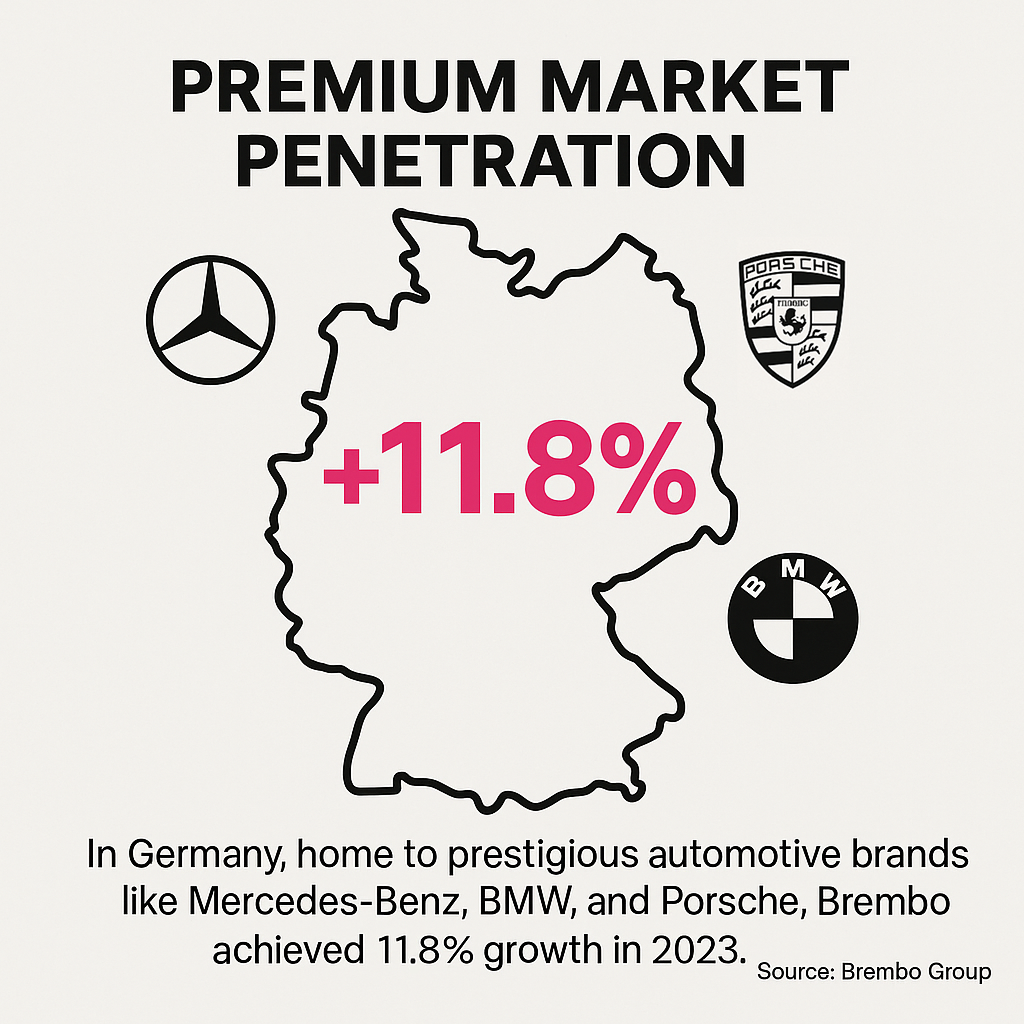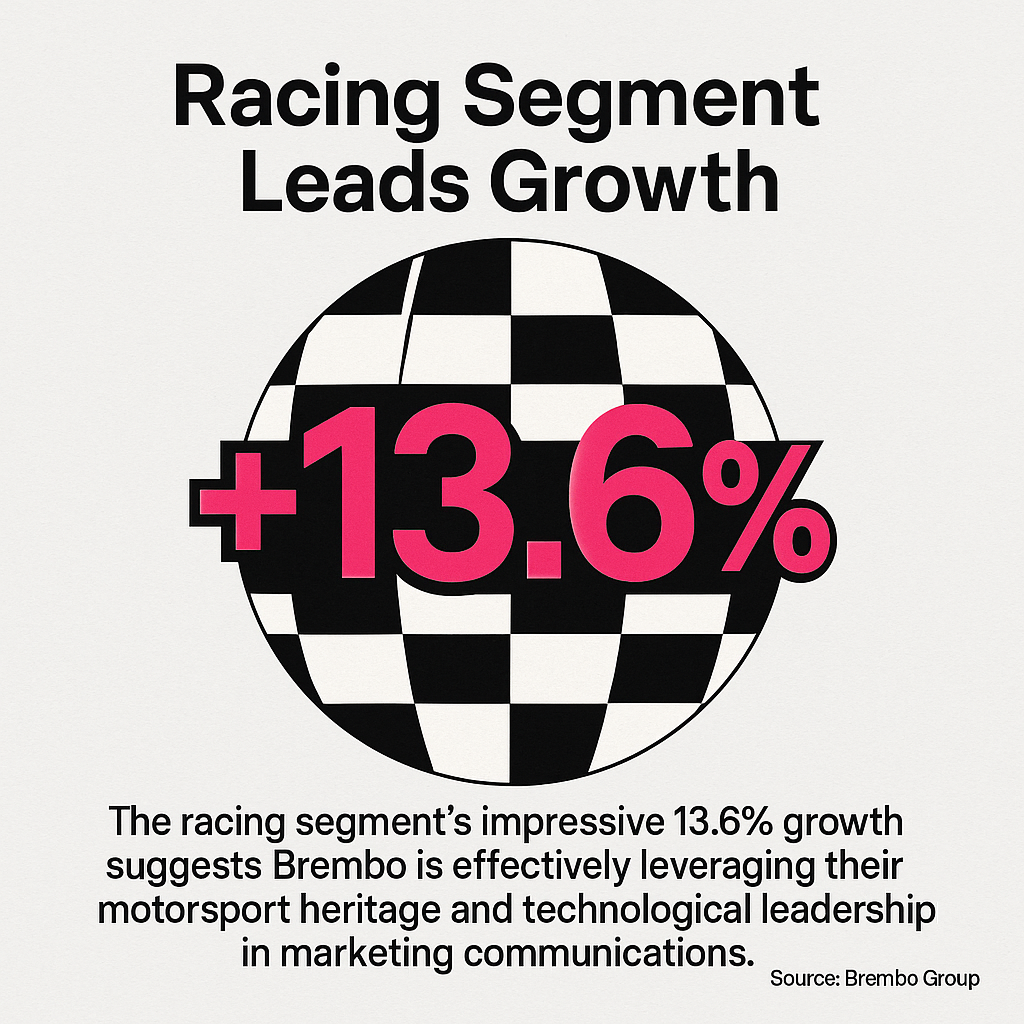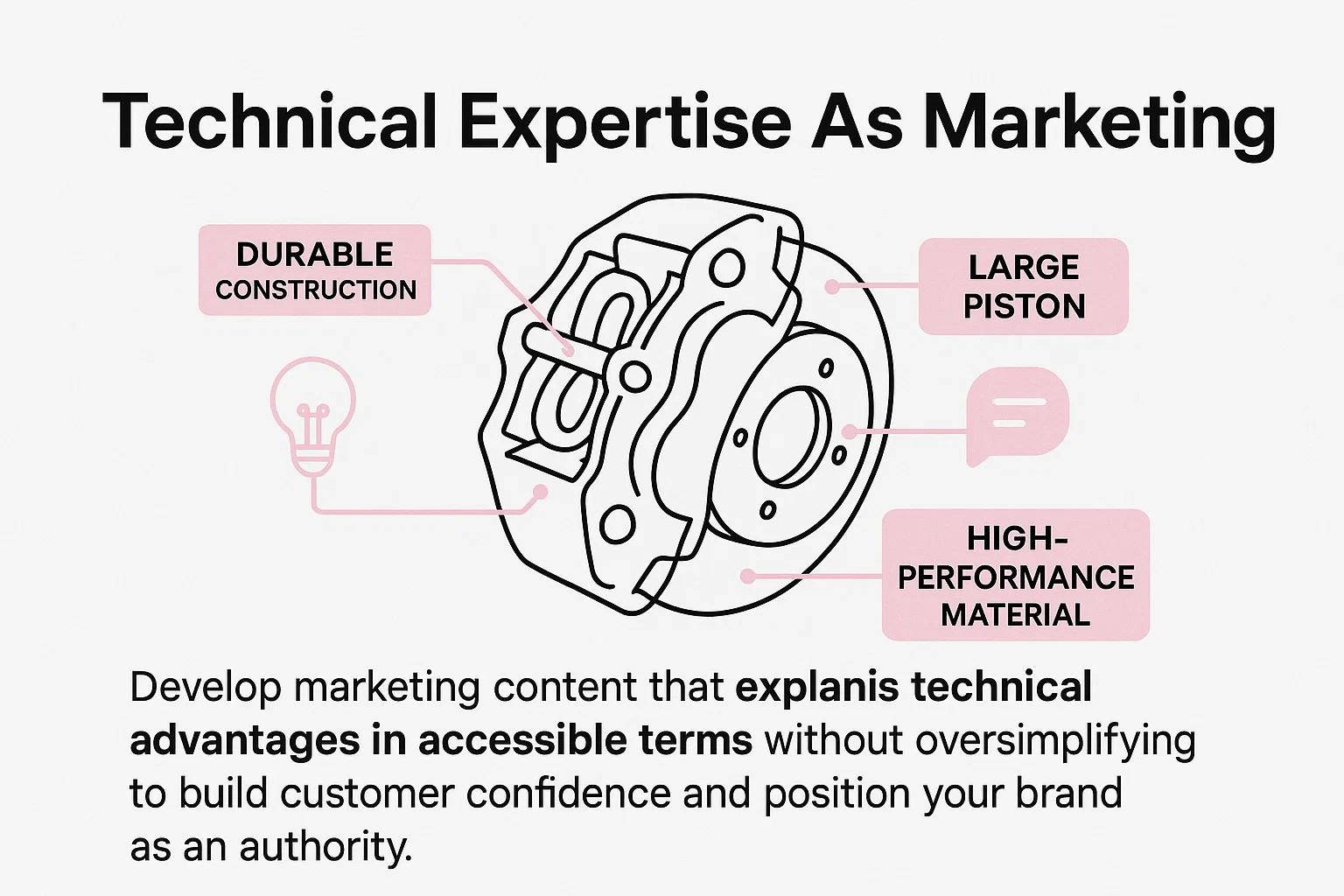.png)
Brembo, the Italian brake manufacturer, has established itself as a global leader in high-performance braking systems. Their iconic red calipers have become synonymous with performance and quality across the automotive world. Running an eCommerce marketing agency specializing in automotive parts, I've always been fascinated by how Brembo has managed to expand globally while maintaining premium positioning. Their success offers valuable lessons for businesses looking to scale internationally while preserving brand value.
In 2023, Brembo achieved remarkable growth with revenue reaching €3.85 billion, representing a 6.1% year-over-year increase. (Source: BMB Consult) This performance is particularly impressive considering the challenging economic climate and supply chain disruptions affecting the automotive industry. By examining Brembo's approach, we can extract actionable marketing strategies applicable to businesses of all sizes.
In this post, I'll break down the key marketing lessons from Brembo's global success story. You'll discover how to apply these principles to your own business, whether you're in automotive parts, eCommerce, or any industry looking to expand into new markets. Let's analyze what makes Brembo's approach so effective and how you can adapt these strategies for your own growth.
Before extracting marketing lessons, let's understand the scale of Brembo's success through their financial performance. The company's 2023 results show not just growth, but strategic expansion across multiple regions and market segments.
Beyond revenue growth, Brembo demonstrated strong profitability with EBITDA reaching €665.8 million (a 6.5% increase) and net profit of €305 million (up 4.2%) in 2023. (Source: BMB Consult Q3) These numbers reflect a company that's not just expanding but doing so profitably – a crucial distinction in today's market where growth at all costs is increasingly scrutinized.
What's particularly interesting from a marketing perspective is how Brembo's performance varies across different regions. This geographic breakdown provides insights into their targeted marketing approaches and regional strategy effectiveness.
Let's examine Brembo's regional sales performance to understand where they're seeing the strongest growth and what this reveals about their global marketing strategy. This analysis helps identify which markets are responding best to their approach and where they might be implementing particularly effective region-specific tactics.

|
Region
|
Growth Rate (2023)
|
Marketing Implication
|
|---|---|---|
|
Italy (Home Market)
|
+1.3%
|
Mature market strategy focused on retention
|
|
Germany
|
+11.8%
|
Strong penetration in premium automotive market
|
|
France
|
+12.4%
|
Successful expansion in European luxury segment
|
|
UK
|
+3.4%
|
Moderate growth despite economic challenges
|
|
North America
|
+5.1%
|
Established presence in performance market
|
|
South America
|
+24.9%
|
Emerging market with aggressive expansion
|
The regional performance data reveals a sophisticated market approach that balances established markets with high-growth opportunities. South America stands out with nearly 25% growth, suggesting Brembo has identified and successfully capitalized on an emerging market opportunity.
This geographic distribution tells an important marketing story: Brembo isn't pursuing a one-size-fits-all approach. Instead, they appear to be implementing region-specific strategies tailored to market maturity and local conditions. In mature markets like Italy, where growth is modest at 1.3%, the focus likely shifts to customer retention and premium positioning. Meanwhile, in high-growth regions like South America, more aggressive expansion tactics are clearly yielding results.
From a marketing perspective, this nuanced approach demonstrates the importance of market segmentation and localized strategies when pursuing global expansion. It's a reminder that effective international marketing requires understanding regional differences rather than applying a uniform approach.
Brembo's financial performance provides quantitative evidence of their success, but what specific marketing strategies have enabled this growth? By analyzing their approach across different segments and regions, we can identify several key strategies.
Brembo has masterfully positioned itself as a premium brand in the automotive component market. Rather than competing solely on price, they've established themselves as the gold standard for performance braking systems. This positioning allows them to command premium prices while building strong brand equity.
The premium positioning strategy is particularly evident in how they've penetrated the luxury automotive market. In Germany, home to prestigious automotive brands like Mercedes-Benz, BMW, and Porsche, Brembo achieved 11.8% growth in 2023. (Source: Brembo Group) This success in markets dominated by luxury vehicles underscores the effectiveness of their premium brand strategy.
For marketers, the lesson is clear: identifying a position of value rather than competing on price alone can lead to sustainable growth and stronger margins. This approach requires consistent quality and clear communication of your value proposition – areas where Brembo excels.
Brembo's regional performance reveals a calculated approach to geographic expansion. They maintain a strong presence in established markets while aggressively pursuing growth in emerging regions with high potential.
Their operations in Mexico provide a compelling example of this strategy. In 2023, Brembo's Mexico operations generated net sales of €531.5 million, representing a significant portion of their North American business. (Source: Brembo Annual Report) This strategic focus on Mexico allows them to serve the North American market efficiently while potentially accessing Latin American markets.
The key marketing lesson here involves identifying strategic geographic entry points that can serve as hubs for broader regional expansion. This approach allows for more efficient resource allocation and marketing spend compared to attempting simultaneous entry into multiple markets.
Beyond geographic segmentation, Brembo demonstrates sophisticated product segment targeting. Their performance across different product categories reveals a nuanced understanding of various market segments' needs and growth potential.
Let's examine Brembo's segment performance to understand how they're allocating marketing resources and attention across different product categories. This breakdown reveals which segments are driving growth and likely receiving focused marketing investment.
|
Segment
|
Growth Rate (2023)
|
Marketing Focus
|
Growth Opportunity
|
|---|---|---|---|
|
Car
|
+7.2%
|
Brand recognition, premium positioning
|
Medium - established but steady
|
|
Commercial Vehicles
|
+7.8%
|
Reliability, total cost of ownership
|
Medium - specialized needs
|
|
Racing Vehicles
|
+13.6%
|
Performance, technology leadership
|
High - halo effect for brand
|
|
Motorbike Applications
|
-4.1%
|
Safety, performance in smaller format
|
Challenged - requires new approach
|
This segment performance data highlights how Brembo tailors its marketing approach to different product categories, with racing applications showing the strongest growth while motorcycle applications face challenges.

The racing segment's impressive 13.6% growth suggests Brembo is effectively leveraging their motorsport heritage and technological leadership in marketing communications. Meanwhile, the decline in motorcycle applications indicates an area requiring strategic marketing adjustment.
For marketers, this segmented approach demonstrates the importance of recognizing that different product categories may require distinct marketing strategies, messaging, and resource allocation. Success in one segment doesn't automatically translate to others, even within the same brand ecosystem.
Brembo doesn't just sell braking components; they market innovation and technological advancement. Their strategic investments in next-generation technologies like the Sensify intelligent braking system and AI-driven Brembo Solutions demonstrate how innovation itself becomes a powerful marketing tool. (Source: Brembo Worldwide)
By consistently pushing technological boundaries, Brembo creates natural marketing narratives around progress and performance. This approach generates media coverage, industry recognition, and customer interest without relying solely on traditional advertising channels.
The marketing lesson here is that product innovation, when properly communicated, can drive brand awareness and perception more effectively than conventional marketing tactics alone. Investing in genuine innovation creates authentic stories that resonate with customers and differentiate your brand.
Now that we've analyzed Brembo's approach, let's extract specific, actionable marketing lessons that businesses of any size can apply. Brembo's success isn't just about being a large corporation with substantial resources – it's about implementing smart strategies that can be adapted to different contexts.
Let's explore how to implement these principles in your marketing strategy.
One of Brembo's strengths is their use of market data to guide expansion decisions. Their remarkable 24.9% growth in South America didn't happen by accident – it resulted from identifying and acting on market data that indicated growth potential. (Source: Brembo Group)
For your business, implementing data-driven decision making in your marketing strategy starts with identifying key metrics that indicate market opportunity. This might include:
- Market size and growth rate
- Competitive intensity
- Customer acquisition costs
- Lifetime value potential
- Regulatory or logistical barriers
By establishing a data framework for market evaluation, you can make more objective decisions about where to allocate your marketing resources. This approach reduces the risk of expanding into markets based on assumptions or personal preferences rather than actual opportunity.
Brembo's varied growth rates across regions demonstrate their ability to adapt marketing approaches to local conditions. This doesn't mean creating entirely different brand identities for each market, but rather adjusting emphasis, messaging, and channel strategy based on regional preferences.
For example, in mature European markets like Germany where they achieved 11.8% growth, Brembo likely emphasizes their engineering excellence and performance heritage – values that resonate strongly with the German automotive culture. Meanwhile, in emerging markets, the focus might shift more toward aspirational messaging and brand building.
To implement this in your business, start by mapping customer journeys in each target market. Look for variations in:
- Purchase decision factors
- Information sources trusted by customers
- Common objections or concerns
- Channel preferences
- Local competitors and their positioning
These insights allow you to maintain a consistent brand while adjusting specific elements of your marketing mix to match regional expectations and behaviors.
Brembo doesn't just have technical expertise – they effectively communicate it as part of their marketing. This approach builds credibility and justifies premium pricing by educating customers about the value they receive.
For businesses in technical fields, including automotive parts, this means treating knowledge sharing as a marketing function. Instead of assuming customers understand your product's technical advantages, make explaining them a central part of your marketing content.
Let's compare traditional marketing approaches with the Brembo-inspired technical expertise model to understand how this shift in thinking can transform your marketing effectiveness:
|
Marketing Aspect
|
Traditional Approach
|
Brembo-Inspired Approach
|
Implementation Tips
|
|---|---|---|---|
|
Value Communication
|
Focus on general benefits and outcomes
|
Detailed explanation of technical advantages
|
Create content that explains "how" not just "what"
|
|
Content Strategy
|
Primarily sales-oriented messaging
|
Educational content that builds credibility
|
Develop technical guides, comparison tools, and explainers
|
|
Customer Targeting
|
Broad audience approach
|
Segmented by technical knowledge level
|
Create content paths for different expertise levels
|
| Competitive Positioning |
General claims of superiority
|
Specific technical differentiators
|
Highlight measurable performance advantages
|
|
Price Justification
|
Based on brand or general quality claims
|
Based on specific technical advantages
|
Connect price premium directly to performance metrics
|
This comparison highlights how a technical expertise-driven marketing approach differs from conventional tactics, creating more substantial differentiation and value perception in the market.

To implement this approach, identify the technical aspects of your product that deliver the most significant customer benefits. Then develop marketing content that explains these advantages in accessible terms without oversimplifying. This builds customer confidence and positions your brand as an authority.
Brembo has successfully created a brand identity centered on performance – their distinctive red calipers have become visual shorthand for high-performance braking. This association allows them to transfer brand equity across different automotive segments and geographic markets.
For your business, building a performance-based identity means identifying a key performance attribute that can become your central brand association. This requires:
This approach is particularly valuable when expanding internationally through digital channels, as a clear performance-based identity can transcend cultural and linguistic barriers more easily than complex brand narratives.
Understanding Brembo's approach is one thing – implementing similar strategies in your business is another. Let's explore practical steps for applying these lessons regardless of your company's size or current market position.
Let's look at how to implement these principles at different stages of your marketing development.
Before implementing new strategies, you need an accurate assessment of your current position. Brembo's success comes partly from their clear understanding of where they stand in each market, allowing for tailored approaches.
Start by evaluating your business against these key dimensions:
This assessment provides the foundation for identifying which Brembo-inspired strategies will be most relevant for your situation. A business currently perceived as mid-market will need a different approach to premium positioning than one already seen as premium but looking to expand geographically.
Brembo's regional performance data shows they prioritize markets strategically rather than pursuing all opportunities simultaneously. For your business, this means developing criteria to evaluate and rank potential expansion markets.
When developing an aftermarket parts business strategy or any eCommerce expansion plan, consider these factors:
This framework helps prioritize markets where your specific advantages will resonate most strongly, similar to how Brembo has found remarkable success in South America and European markets like Germany and France.
Brembo's varied performance across product segments demonstrates the importance of tailored marketing approaches. Their racing segment grew by 13.6% while motorcycle applications declined by 4.1%, suggesting different strategies for each segment. (Source: Brembo Group)
To implement a segment-specific approach effectively, let's look at a framework that can be adapted to businesses of different sizes and stages. This implementation table provides a structured way to develop targeted marketing strategies for different business contexts.
|
Business Size
|
Resource Allocation
|
Geographic Approach
|
Premium Positioning Tactic
|
Technical Marketing Focus
|
|---|---|---|---|---|
|
Startup/Small Business
|
Focus 80% on single best segment
|
Start local, expand regionally
|
Niche specialization and expertise
|
Founder/team knowledge as content
|
|
Mid-Size Business
|
70% primary, 30% secondary segments
|
Target top 2-3 growth markets |
Case studies and social proof
|
Comparative testing and results
|
|
Enterprise
|
Portfolio approach across segments
|
Simultaneous multi-market strategy
|
Innovation leadership and R&D stories
|
Technical partnerships and certifications
|
|
Aftermarket Focus
|
Segment by vehicle type/age
|
Target markets with compatible vehicle base
|
OEM-equivalent or better messaging
|
Performance testing vs. OEM parts
|
This implementation framework helps businesses of different sizes adapt Brembo's segment-specific marketing approach to their particular circumstances and resources, providing a roadmap for execution.
By creating distinct marketing plans for different segments, you can allocate resources more effectively and develop messaging that resonates with each audience's specific needs and priorities.
By avoiding these traps, you can implement segment-specific marketing that maintains brand coherence while addressing distinct customer needs.
Implementing Brembo-inspired strategies requires appropriate measurement frameworks to track progress and optimize performance. Let's examine how to establish metrics that align with this marketing approach.
Brembo's financial results demonstrate the importance of tracking both growth and profitability metrics. Their 6.1% revenue growth accompanied by 6.5% EBITDA growth shows they're expanding without sacrificing margins – a key indicator of successful premium positioning. (Source: BMB Consult)
When implementing a premium, technical marketing approach inspired by Brembo, track these KPIs:
These metrics help determine whether your premium positioning strategy is resonating with customers and translating into sustainable business results.
Premium positioning strategies like Brembo's typically don't deliver overnight results. Their current market position represents decades of consistent brand building and performance delivery.
For your implementation, establish timeline expectations based on your starting position:
- Short-term (3-6 months): Content engagement metrics, audience growth
- Medium-term (6-12 months): Conversion improvements, initial margin increases
- Long-term (12-24+ months): Brand perception shifts, sustainable premium positioning
Setting realistic timelines prevents premature abandonment of strategies that require time to generate results. Premium positioning in particular often shows stronger results in retention and margin before significantly impacting acquisition volume.
Brembo's varied performance across segments suggests they continually refine their approach based on results. Their strong performance in racing (+13.6%) contrasted with challenges in motorcycle applications (-4.1%) likely informs ongoing strategy adjustments.
Tracking these metrics allows for data-driven refinement of your strategy, focusing resources where your premium, technical approach generates the strongest response.

Brembo's success in global markets provides a masterclass in premium positioning, technical marketing, and strategic expansion. Their ability to grow revenue by 6.1% while improving EBITDA by 6.5% demonstrates that a premium, performance-based approach can deliver both top-line and bottom-line results. (Source: BMB Consult)
The key marketing lessons from Brembo's approach include:
For businesses looking to apply these principles, success depends on realistic assessment of your starting position, strategic prioritization of opportunities, and patience in building premium positioning over time.
I've seen firsthand how automotive parts businesses can transform their market position by focusing on technical excellence and performance benefits rather than competing primarily on price. The approach requires commitment and consistency, but the rewards include stronger margins, more loyal customers, and greater resilience against commodity competition.
Remember that building a premium, performance-based brand like Brembo takes time, but the competitive advantages it creates are substantial and sustainable. By focusing on genuine technical excellence and communicating it effectively, you can create market positioning that competitors find difficult to replicate.
Ready to apply these lessons to your marketing strategy? Our team at Scube Marketing specializes in helping businesses (especially aftermarket auto parts ecommerce) implement premium positioning and technical marketing approaches that drive sustainable growth. Contact us to discuss how these principles can be tailored to your specific business context.
Our customers value boutique agency approach with access to a seasoned team, profit-based goals, and clear communication.



